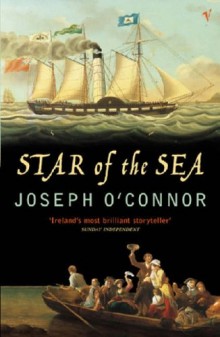 Star of the Sea
Star of the Sea
General Fiction, Irish
Vintage Books
2003
410

The Star of the Sea is the ironic name of one of the coffin ships that made it’s way painstakingly slowly from Ireland to America during the time of the famine. Carrying a load of Irish peasants who lived in squalor that was inhumane in the least this novel depicts the journey of those on board.
From the outset we are informed that their has been a murder on the ship and the reader is forgiven for thinking that maybe they have actually picked up a murder/mystery book, but it is far more than that.
Our main characters are Thomas David Nelson Merridith, aka Lord Kingscourt, his wife Laura and two sons, he of course is travelling first class, occupying several of the fifteen staterooms. His family have lived in Ireland for the last 90 years, and have extensive holdings in Kingscourt, however through his father’s mismanagement, the failure of the potato crop and a debt owed to another protestant landowner, Lord Kingscourt is bankrupt, with former tenants threatening his life he has no alternative to flee. Accompanying the Merridith family is their children’s nanny, Mary Duane, a woman who grew up on the estate as the child of hardworking tenants.
G. Grantley Dixon, an American reporter, also travelling first class, is a caricature of the liberal American do-gooder whose reports about the plight of the Irish poor are influenced by his own socialism and by the reform-minded traditions of his family. Self-centered in his attitudes and limited in his social graces, he is detested by Merridith and resented by many others aboard the ship.
Pius Mulvey, missing part of a foot after an attack by a carnival lion, is the mysterious ex-convict whose presence on the ship is crucial to the action. Coming from the same town as Merridith and Mary Duane, he is directly connected to both of them. Physically tortured by a group of violent rebels in Ireland before his departure, he is assigned to kill Merridith while he is on the ship, or be killed himself. Mulvey haunts the ship’s decks at night and sleeps all day as he tries to stay alive long enough to reach New York. One of over 400 passengers who have paid $8 per person for passage, he is crammed into the fetid and dangerous quarters known as “steerage,” expected to stay alive on one quart of water a day and half a pound of hardtack.
It’s a gripping tale indeed: we follow the ship day by day on its perilous winter crossing. The story is told from various points of view, including the captain’s log, letters from or to or about one or another of the passengers, and through Dixon’s eyes as he puts the story together some 40 years after these events, after nearly every other survivor of the trip is dead. The details of the voyage are interspersed with these other documents, which look both backward and forward in time, a device which at times helps the reader piece together the tale.
In writing this novel O’Connor has managed to write a piece of work that is an education in itself, Star of the Sea speaks to us about the enmeshed histories of England, Ireland and America, and a lesson on the evils of serfdom and exploitation. Go out and buy it. ![]()




